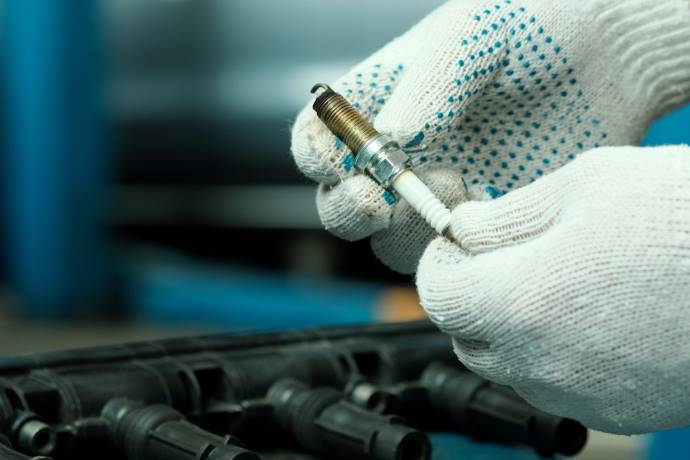A car that idles smoothly but sputters when accelerating is a frustrating experience for any driver.
This issue makes it difficult to maintain a consistent speed and sometimes even leads to stalling the engine.
While there are many potential causes of a car sputtering when accelerating, some of the most common problems include a faulty fuel system, exhaust system, and engine sensors.
Ignoring the problem can cause severe problems for the vehicle. Therefore, it is crucial to identify the exact cause and address it as soon as possible.
In this article, I have explained the most common causes of a car sputtering when accelerating and how to address them.
6 common problems that are responsible for a “car idles fine but sputters when accelerating,” including a faulty fuel system, faulty mass airflow sensor, worn spark plugs, a faulty throttle position sensor, faulty catalytic converter, and vacuum leaks.
1. Faulty Fuel Pump
The most common cause of car sputtering when accelerating is a faulty fuel system, which disrupts the flow of fuel to the engine or delivers a poor-quality fuel mixture.
During normal operation, the fuel pump delivers fuel to the engine at a specific pressure.
This pressure ensures that the fuel injectors are able to deliver the correct amount of fuel to the cylinders.
When the fuel pump fails, the fuel pressure drops.
Therefore, the fuel injectors deliver less fuel, resulting in a lean fuel mixture.
A lean fuel mixture causes misfires, which can ultimately cause the engine to sputter and stall, especially when accelerating.
However, before diagnosing the fuel pump, you should ensure that the following components are in good working order:
- Fuel is at a sufficient level because lack of fuel causes the engine to sputter or stall.
- Make sure the fuel filter is not clogged. Otherwise, it causes a lean fuel mixture and misfiring.
- Ensure the fuel quality is high. Using poor-quality fuel also leads to engine sputtering, as it contains impurities.
Symptoms of a Faulty Fuel Pump
- Car sputters and stalls when accelerating
- Rough idle
- Misfiring codes detect
- Vibrating when accelerating
- Engine overheating
- Unusual sound from the exhaust
How to Fix a Faulty Fuel Pump
The best way to fix a faulty fuel pump is to replace the fuel pump.
Replacing a faulty fuel pump typically costs around $600 to $1,100.
Here are some tips to avoid a faulty fuel pump:
- Keep the fuel tank full. Running on a low-fuel tank starves the fuel pump and causes it to overheat.
- Change the oil regularly. Clean oil helps to lubricate and cool the fuel pump.
- Use a fuel additive. Some fuel additives help to clean and protect the fuel system.
2. Faulty Mass Airflow Sensor
The mass airflow sensor has a significant impact on the vehicle’s performance.
A faulty mass airflow (MAF) sensor causes the car to sputter when accelerating by providing an incorrect air flow reading to the engine control module (ECM).
The engine control module calculates fuel injection rates based on these readings.
If the MAF sensor overestimates the airflow, the ECU injects too much fuel, causing a rich mixture.
A rich fuel mixture drives the engine to sputter and hesitate, especially when accelerating.
Symptoms of a Faulty Mass Air Flow Sensor
- Car sputters and hesitates when accelerating
- Rough idle
- Black smoke from the exhaust
- Increased fuel consumption
- Reduced engine performance
How to Fix a Faulty Mass Air Flow Sensor
There are two ways to fix the MAF sensor:
1. Clean the MAF Sensor
The MAF sensor becomes dirty over time, which causes it to provide inaccurate readings.
Cleaning the MAF sensor will sometimes solve the problem.
However, I recommend it be done only if the MAF sensor is new.
Otherwise, this will not be an effective solution.
2. Replace the MAF sensor
The best solution for any faulty sensor is to replace it.
If you have already driven 100,000 miles, you should replace the sensor.
Because cleaning will no longer be effective after this time, and you will continue to face the same issues.
Replacing a faulty MAF sensor costs around $230 to $350.
How to Prevent a Faulty MAF Sensor
- Use a high-quality air filter. A dirty air filter restricts the airflow to the MAF sensor, causing it to provide inaccurate readings.
- Avoid driving in dusty or sandy conditions.
- Ensure regular service by a professional mechanic.
3. Worn Spark Plugs

During normal operation, the spark plug ignites the air-fuel mixture in the cylinders by producing a spark.
This ignition process creates the combustion that operates the engine efficiently.
When spark plugs wear out, the gap between the electrodes widens.
This makes it more difficult for the spark plugs to jump the gap and ignite the fuel mixture.
When the spark is inconsistent, it causes misfires.
Ultimately, misfires cause the engine to sputter and hesitate, especially when accelerating.
Symptoms of Worn Spark Plugs
- Engine sputters when accelerating
- Rough idle
- Engine misfiring
- Reduced fuel economy
- Engine surging
- Difficulty starting
- Lack of acceleration
How to Fix Worn Spark Plugs
The most effective solution for worn spark plugs is replacement.
How to Avoid Spark Plugs from Failing
- Ensure regular tune-ups. Tune-ups typically include a spark plug replacement.
- Choose high-quality spark plugs that last longer and produce a stronger spark.
- Avoid driving in dusty conditions.
4. Faulty Throttle Position Sensor
A faulty throttle position sensor is responsible for the problem.
The throttle position sensor (TPS) is positioned on the throttle body. This sensor controls the amount of air that enters the engine.
The TPS sends a signal to the ECU to indicate the position of the throttle plate. The signal helps the ECU identify the amount of fuel that is injected into the engine.
If the TPS is faulty, it can send incorrect alerts to the ECU.
Therefore, the ECU delivered an incorrect fuel mixture, leading to the sputtering problem.
Symptoms of a Faulty Throttle Position Sensor
- Sudden surges in speed when driving on the highway
- Sudden idle surges
- Sputtering or hesitation while accelerating
- Unexplainable jerking in the vehicle
- Check engine light illuminates
How to Fix a Faulty Throttle Position Sensor
Replace the TPS; this is a relatively simple and effective solution.
When replacing the TPS, clean the throttle body and throttle plate properly.
Check the throttle cable and linkage for damage.
Also, inspect the intake manifold for leaks.
How to Prevent a Throttle Position Sensor from Failing
- Keep the air filter clean.
- Avoid overfilling the fuel tank.
- Use high-quality fuel.
5. Faulty Catalytic Converter

A faulty catalytic converter is one of the most common causes of engine sputtering.
During normal operation, the catalytic converter converts the harmful exhaust gases into less harmful gases.
When the catalytic converter fails, it becomes clogged or restricted.
As a result, the exhaust gases return to the engine, increasing the exhaust pressure.
The increasing exhaust pressure causes the engine to misfire when accelerating.
This is because the engine is working harder and requires more air to burn the fuel.
So, when the exhaust pressure is too high, the engine does not get enough air, resulting in misfires and sputtering.
Symptoms of a Faulty Catalytic Converter
- Engine overheating
- Reduced engine power and performance
- Smell of sulfur or rotten eggs from the exhaust
- Reduced acceleration
How to Fix a Faulty Catalytic Converter
Replacing the faulty catalytic converter is one of the guaranteed ways to fix it.
The replacement cost of a faulty catalytic converter is around $600 to $2,500, depending on the vehicle make, model, and location.
How to Prevent Catalytic Converter from Failing
- Avoid using leaded gasoline, as this can damage the catalytic converter.
- Change the oil regularly. Unburned fuel clogs the catalytic converter. Using clean oil helps to prevent unburned fuel from entering the exhaust system.
- Avoid driving with a misfiring engine. This can damage the catalytic converter and ultimately result in the engine sputtering.
6. Vacuum Leaks
The vacuum line helps to create a vacuum in the intake manifold.
This vacuum helps draw air into the engine and control fuel flow to the cylinders.
When there is a vacuum leak, unmetered air enters the engine through the leaks.
This unmetered air disrupts the air-fuel mixture.
Therefore, the engine misfires and causes engine sputtering.
Symptoms of Vacuum Leak
- Excessive fuel consumption
- Check engine light and codes
- Rough idle
- Difficulty starting issue
How to Fix Vacuum Leak
Follow these 4 steps given below to fix the vacuum leak issue:
- Inspect the vacuum lines for cracks, splits, or loose connections. Replace any damaged lines.
- Check the vacuum hoses for leaks. The easy way to do this is by spraying soapy water on the hoses while the engine is running. If you see bubbles forming, there is a leak.
- Check the intake manifold gasket for leaks. This can also be done by spraying soapy water on the gasket while the engine is running. If any bubbles form, there is a leak.
- Check the EGR valves for leaks with soapy water. Spray the soapy water on the EGR valve while the engine is running. If bubbles form anywhere, there is a leak.
How to prevent Vacuum Leak
- Regularly inspect the vacuum lines and hoses for cracks, splits, or loose connections.
- Tighten any loose connections.
- Replace if any lines or hoses are damaged.
- Check the intake manifold gasket and replace it if necessary.
- Check the EGR valve periodically.
What is Engine Sputtering

Engine sputtering, also known as misfiring, is an irregular firing of the combustion process in a vehicle’s engine.
It is a phenomenon in which the engine produces irregular and uneven bursts of power while accelerating or maintaining a constant speed.
This uneven combustion causes a noticeable jerking, popping, or hiccupping noise.
While the causes of engine sputtering are diverse and multifaceted, it is crucial to understand the fundamental workings of an engine to diagnose and address this issue effectively.
An internal combustion engine operates through a series of intricate processes.
Air draws in the engine’s cylinders, and fuel is injected with the air in a specific ratio.
Then, the spark plug ignites or burns the air and fuel mixture in the cylinder, causing a controlled explosion.
Therefore, the pistons in the engine move, which drives the vehicle’s wheels.
For the engine to perform optimally, these processes must occur harmoniously and synchronized.
If they are disrupted, as in the case of engine sputtering, it causes loss of power and efficiency, reduced fuel economy and performance, and a rough or jerky ride.
Engine sputtering disrupts the smooth and precise operation of internal combustion, causing irregular bursts of power during vehicle operation.
Symptoms of Sputtering Engine

The symptoms of a sputtering engine are:
- Hesitation or jerking during acceleration
- Rough or unstable idle
- Reduce engine power
- Misfire codes detected by the engine control module (ECM)
- Popping or hiccupping sounds from the exhaust
- Vibrations or shaking throughout the vehicle
You may also like to read about the symptoms of bad hydroboost duramax.
FAQs
Can bad spark plugs cause sputtering?
Yes, bad spark plugs cause sputtering.
Worn or dirty spark plugs cannot produce a strong enough spark to ignite the air-fuel mixture in the cylinders.
As a result, the engine misfires and causes sputtering.
What are the symptoms of a fouled spark plug?
The symptoms of a fouled spark plug include the following:
- Hard starting
- Rough idling
- Misfires
- Reduced engine power
- Decreased fuel economy
Inspect the spark plugs and replace them if they are worn out if you are experiencing these symptoms.
Can low oil cause stuttering?
Yes, low oil can cause the vehicle to stutter.
When the oil level is low, the engine does not get enough lubrication, which causes the parts to rub against each other and create friction.
This friction causes the engine to overheat and misfire, which leads to stuttering.
Can a bad catalytic converter cause sputtering?
Yes, a bad catalytic converter causes sputtering.
A clogged or damaged catalytic converter restricts the flow of exhaust gases and causes the engine to misfire.
Does a dirty air filter cause your car to jerk?
Yes, a dirty air filter causes your car to jerk.
It does this by restricting the airflow into the engine, which causes the engine to run lean.
And a lean air-fuel mixture causes the engine to misfire and jerk.
Final Thoughts
Remember that driving with a sputtering engine can damage the engine and lead to costly repairs.
So, if you are experiencing any engine sputtering symptoms, take the necessary action or bring your vehicle to a professional mechanic ASAP.
To help prevent engine sputtering, it is important to keep your car properly maintained.
Using high-quality fuel and avoiding running on low fuel are also important.

